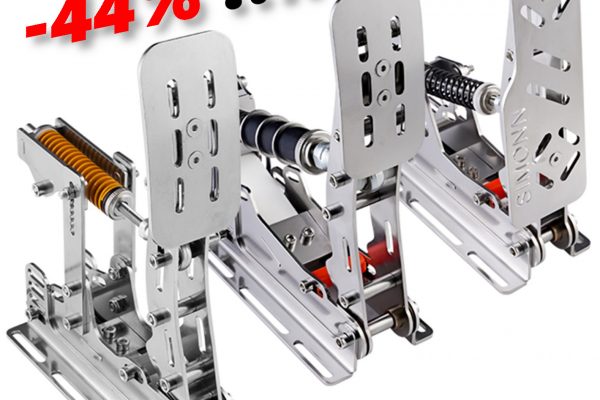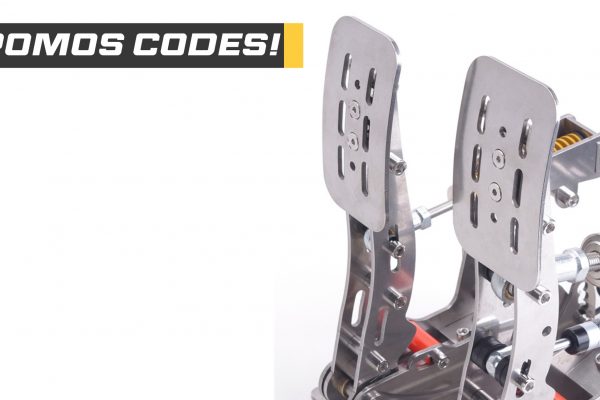With the appearance in 2016 of the first consumer VR headsets (Vive, Oculus…), the technical challenges inherent to VR headsets appear. Among these challenges is the difficulty of transferring via a single cable images, data and power, over a length exceeding 2m.
VirtualLink was a computer standard that was supposed to address this challenge! Find out more about this technology and why it completely disappeared before its first uses!
Contents :
- Introduction
- VirtualLink specifications
- Where is VirtualLink
- The Stability of VirtualLink
- VirtualLink Integration
- Example of integration
- Conclusion
Introduction
2016 : The VR headset is connected with a display port cable topped by a USB cable with also the power supply needed for the headset. In a stationary position the cables remain a bit annoying on the head but the immersion is satisfying. The Vive promises an ultimate experience thanks to the motion sensors that must be distributed throughout the room detecting the headset in space with a precision never reached.
And for those who tested the Vive at its inception was a real slap in the face, never the future seemed so close, we had crossed a milestone.
But as the hours, days and games went by, inconveniences appeared, especially in terms of ergonomics, the headset lacking, for example, optical adjustments, but also those damn cables that tend to quickly destroy the immersion. You quickly get your feet caught in them and you have to be careful not to pull on them or you will disconnect the helmet or worse, especially during sessions with a lot of movement.
To this, manufacturers have tried to respond with several solutions.
The first one was the one proposed by MSi with a briefcase equipped with a laptop directly connected to the helmet. No more wires in the feet, no more problems (no more money either). We will also have the appearance of the module to transform the Vive into a wireless headset.
These solutions are certainly interesting but they have a problem, the price. Spending 400€ on a VR headset is not for everyone
Thus appeared the idea of making a single connector that could dominate all and together link them in VR: The VirtualLink.
The latter appeared with the advent of the RTX 2000. A single cable that would considerably relieve the whole (the Vive was powered by three cables: image/USB/PSU), subtracting the problems of power supply and allowing to standardize the connection of VR headsets. Let’s find out what the VirtualLink is, the problems it encountered and the lack of consideration that led to today’s situation: the death of the VirtualLink
The VirtualLink specification
Here, first of all, is a small table summarizing the different characteristics of the different standards associated with the physical connector of the USB-C (basically you use in 99% of cases the third standard: Alt-Mode):
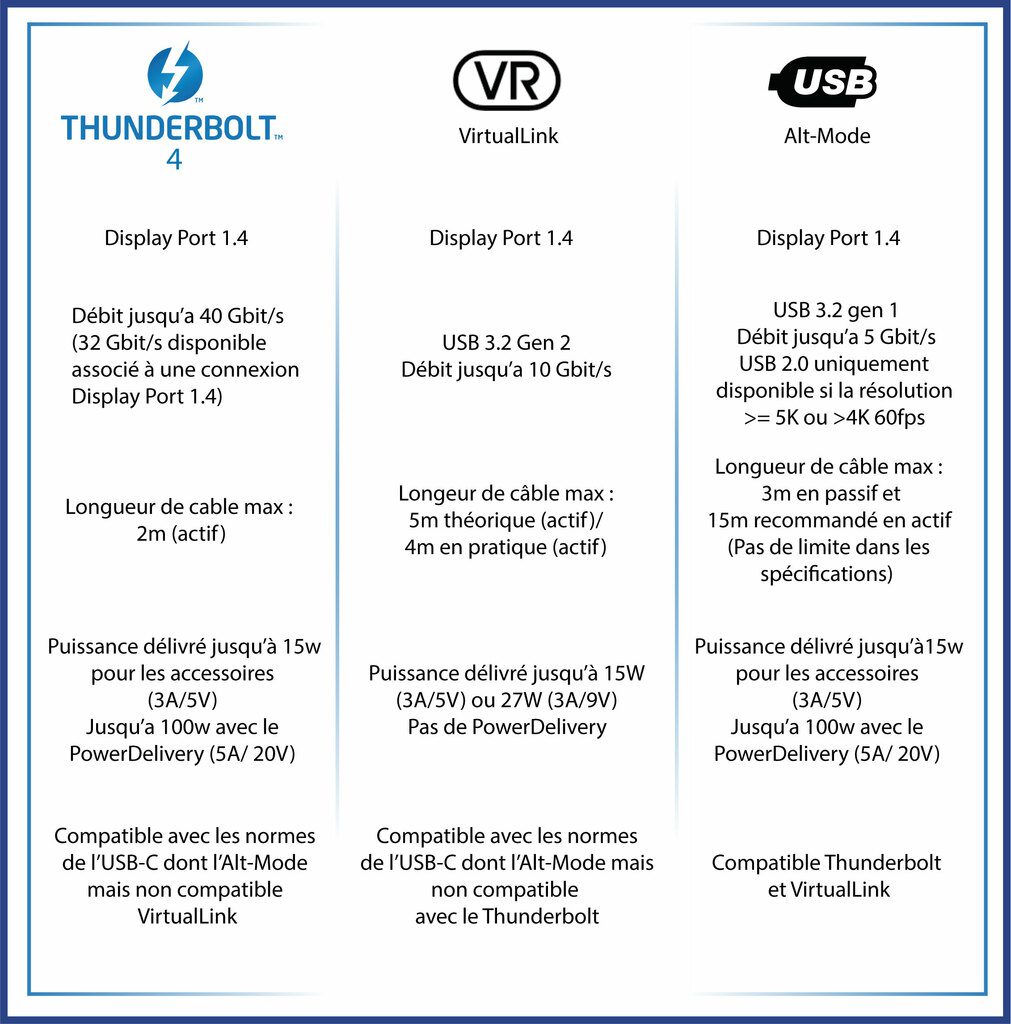
(NB: An active cable is a cable that has within it controllers with either re-timer or re-drivers to re-boost the signal, this to extend the length of the cable well beyond the maximum length of a passive cable)
To quickly introduce you to the USB-C connector here is a small diagram:
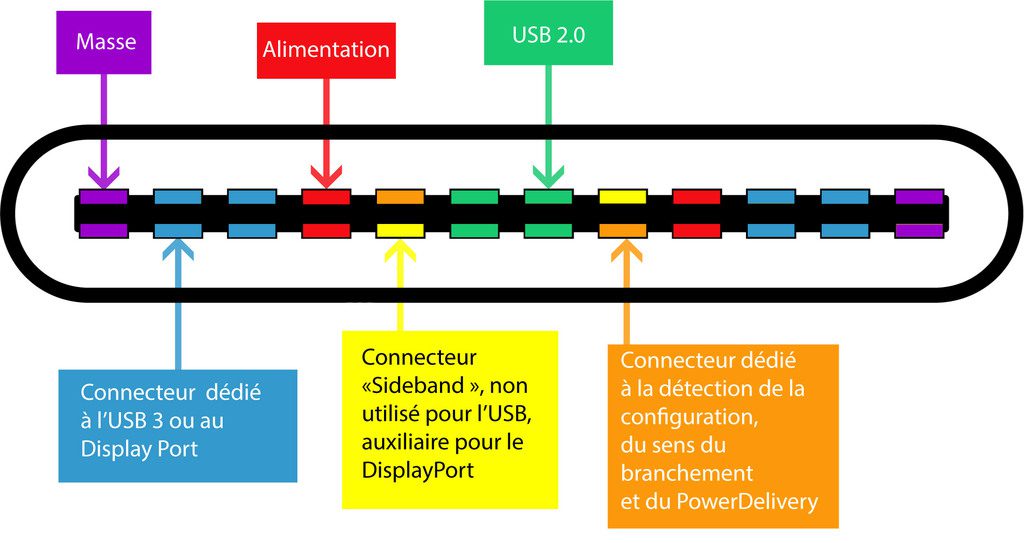
Below we have an illustration of how the pins are used in VirtualLink. We can see that all the blue pins previously used in data transmission are here dedicated to the Display Port only, and all the lines for USB 2.0 are converted to USB 3.0 to get a 10Gbps speed, unlike the alt mode (classic Usb-C) which allows only 5Gbps.

Basically: [DP] = Display Port = Image, TX/RX = data in USB3.
The development was supported by the consortium of major players in virtual reality with AMD, Oculus, Valve, Nvidia and Microsoft. All in all, a great group of people.
To summarize the VirtualLink:
4 lines are dedicated to the connection of the display port 1.4
2 lines to USB 3.1 gen2 (well named USB 3.1 or USB 3.2 gen2 or 3.2 gen 2×1 or if you prefer SuperSpeed USB+) with a speed of 10Gbps
A power supply that can provide 27w instead of the conventional 15w
This standard is not compatible with Thunderbolt, for example, since the latter does not have the necessary channels to transmit USB 2.0; almost a crime of lèse-majesté for USB.
But this “inconvenience” of the disappearance of USB 2.0 is quickly compensated for since in conventional Alt-mode if the resolution exceeds 4K 60 fps, which is often the case, we find ourselves with only USB 2.0. But VirtualLink was thought as a standard for future VR headsets. So having a 20x higher throughput compared to USB 2.0, thanks to USB 3.2 gen 2, is a significant advantage.
Now that we’re done with the technical details, let’s take a look at what happened to the VirtualLink.
Where is the VirtualLink?
First of all, no consumer VR headset has the famous VirtualLink for the moment. Moreover, while the RTX 2000 supported it, the RTX 3000 saw this connector disappear. We can assume that this is not necessarily related to the increase that this would have induced on the TGP (Total Graphic Power) of the RTX 3000 already very high (I say this because I saw some articles put forward this point to explain the death of the VirtualLink) since Nvdia clearly indicates that the increase in TGP induced by the use of the VirtualLink is not taken into account in the TGP displayed.
So the VirtualLink did not even really last more than a year and a half. One could argue that it is currently supported by AMD’s RX6800, Rx 6800XT and RX 6900XT but this is a misleading statement. If AMD integrates VirtualLink with its Navi 21 it doesn’t necessarily mean anything. The first Navi 21 models date back to January 2020 according to the first leaks, with cards already working at the time it would have been an absurdity when designing the card not to integrate VirtualLink. To make a long story short, this is probably just a marketing move by the reds: to show that they are pro-VR by highlighting the VirtualLink port. But unless AMD puts money on the table to promote the standard, VirtualLink is dead (yes, it’s sad).
To finish putting the poor inanimate body of VirtualLink in the grave, the site itself no longer exists.
But then we can ask ourselves the legitimate question of why? Lack of means, no motivation from VR headset manufacturers?
VirtualLink stability
Valve itself has cancelled the VirtualLink adapter for its headset, explaining that it had stability problems and did not want to continue the costs, even though some pre-orders were placed. However, another smaller company like VRgineers has built a headset on this connector that allows the connection of eye-tracking and hand-tracking modules as well as lighthouse mounts. If the name of this company is unknown to you, the headset may be a little less if you are used to VR headsets: the XTAL.
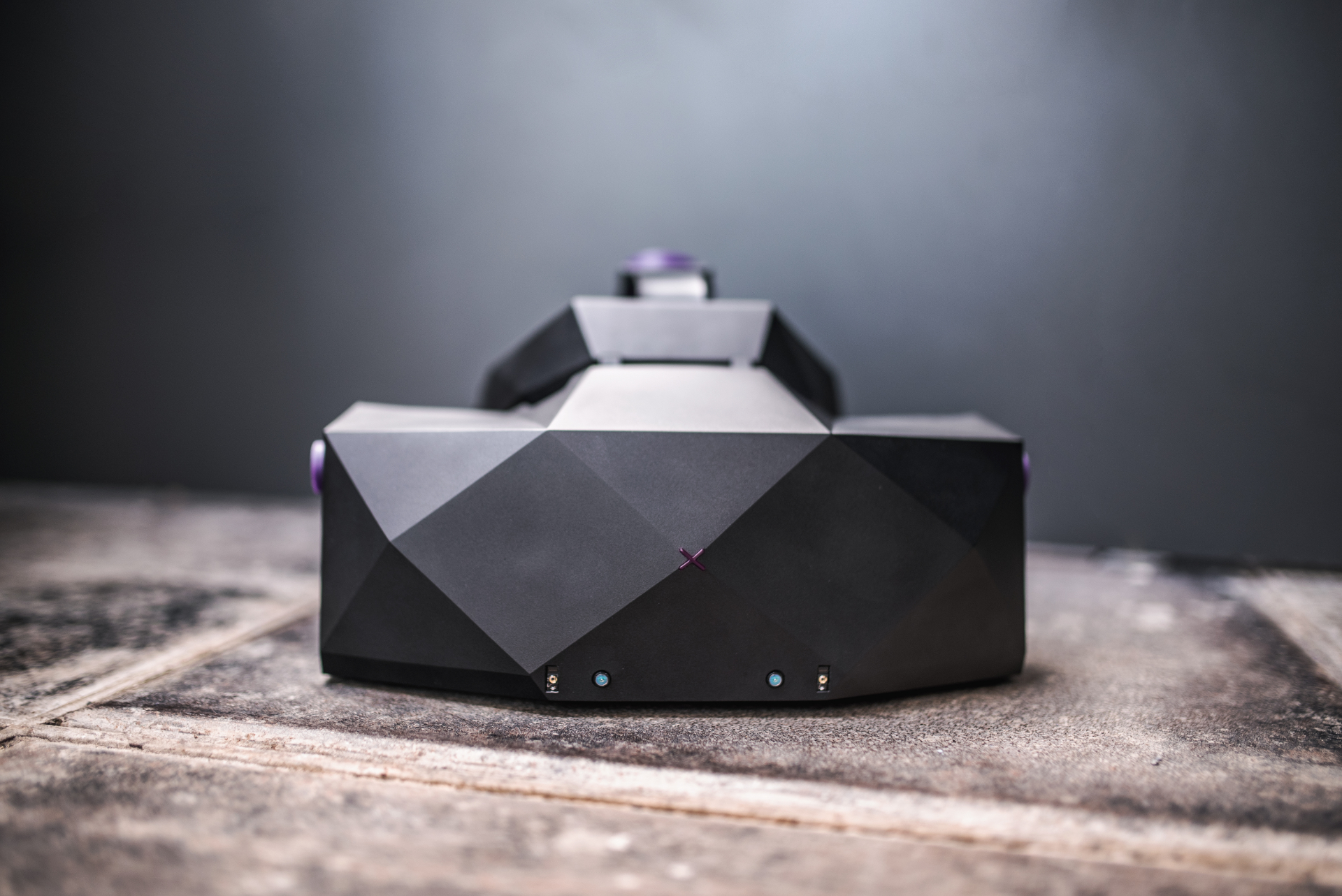
This headset is certainly one of the most advanced in its design, it costs no less than 5000 €. Unfortunately as you can see the site is no longer updated and several pages are missing, its marketing seems to be at a standstill on the general public side. On the other hand, their target market is rather large companies, or even the army, given the exorbitant price and the number of features that the helmet has.
This helmet is still a semi-prototype and even if the integration of the VirtualLink is a success, everything is not rosy and no one has really been able to test the helmet outside of events like CES.
Therefore, it is likely that they have not solved all the problems. To give you an idea, it took Intel 5 years to increase the maximum length of the Thunderbolt cable from 0.80m to 2m and therefore from version 3 to version 4. The length is problematic on this kind of protocol and allowing a stable link is not an easy task. To solve the stability problems in less than a year after the first tests with few standard solutions would have been illusory.
Very good but what is the maximum length of a USB 3.2 cable?
I left out one detail, USB is a mess. Nobody agrees on the maximum length in passive, not even the manufacturers. The bandwidth decreases with a certain length, the more or less shielded cables play a role in the final loss of throughput. I’m talking of course in passive (without power supply in the middle that comes to give a boost). Therefore some people talk about a maximum length where the protocol would stop working and others about a maximum length where the throughput will stop being at its theoretical maximum. So the ideal length of USB 3.2 is 1m. Just 1m not more.
If we look at the VirtualLink documents, the maximum length is 5m since beyond that the loss in dB is too important. However, the document in question was only a preliminary specification. USB3 signal conditioner indicates that the cable must be active but no mention of the solution used.
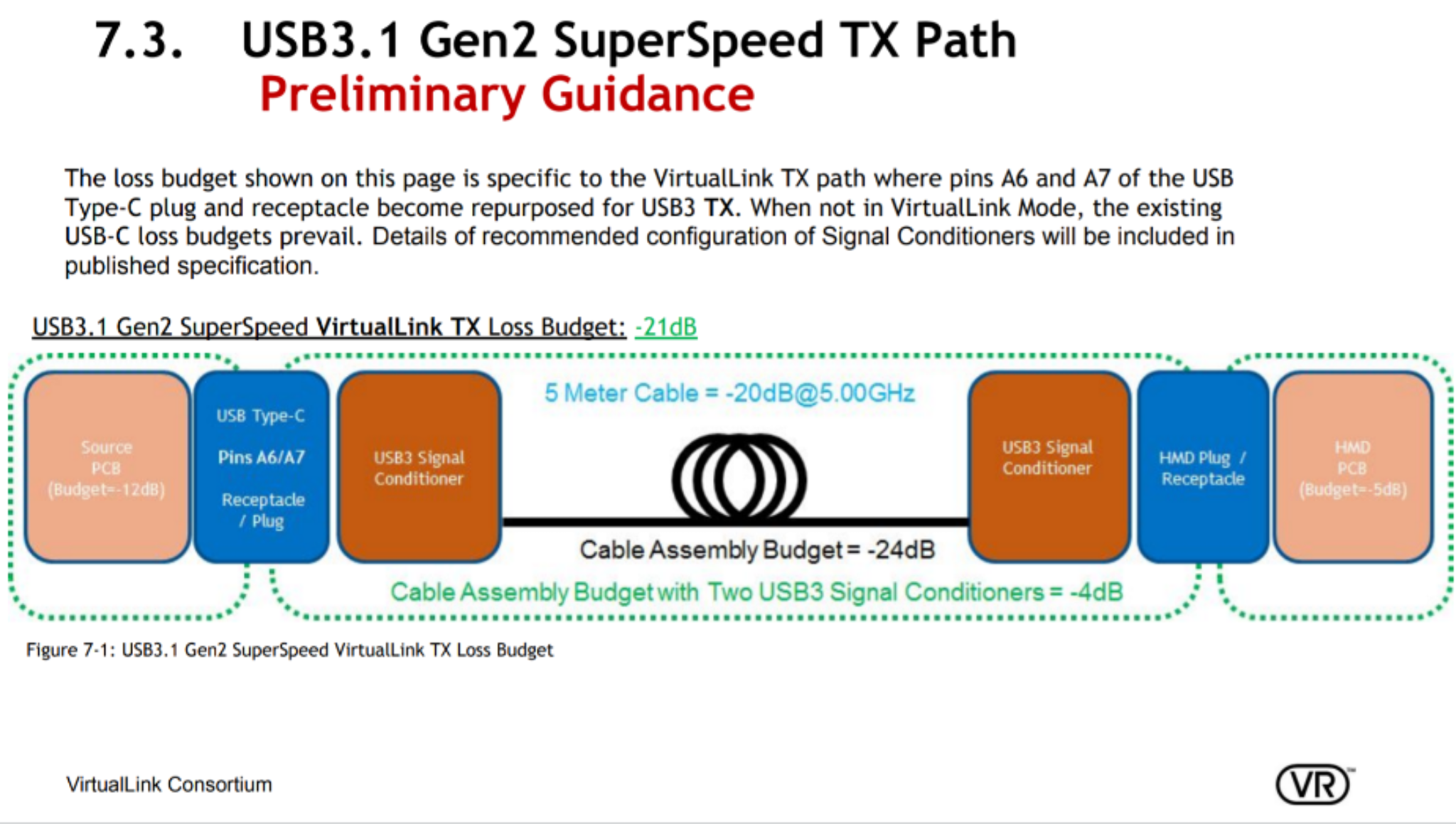
In addition, unless you have little or no need for a large wire distance, you will need an HMD like on the Vive to amplify the USB signal and that of the display port again. In short, we are not at the end of our torments.
(NB: The HMD corresponds to the connection box found on the Vive, for example, which acts as an intermediary between the PC and the headset)
Now that we have eliminated Valve and Nvidia from the equation, there remains the other major player in VR: Oculus.
The latter has 2 headsets in its catalog, the Rift S and the Quest 2. I’m not going to dwell on the headsets themselves but rather focus on the latest cable from Oculus, the well-named “Oculus-Link” (they really didn’t bother with the name…)
It looks like a USB-C cable, it smells like a USB-C cable, bingo it is a USB-C cable. But then why it is ultimately proprietary. First of all, several people have naturally tried to use any USB-C cable with the Oculus Quest 2 and …. it works, it really works, nothing to say about that. On the other hand, it strangely does not charge. Oh and a little subtlety, the unofficial cables stop at 3m where the official cable goes up to 5m. The official cable is actually made of optical fiber, which is much less sensitive to signal loss over the length. To reach 5m in copper no miracle, you need an active system.
I will make a parenthesis on the latency problems: clearly have 45ms or 50ms of latency while in wifi is 30ms, it is incomprehensible. Basically, Oculus saw the wind change and made its own connection system. Here no display port, only USB, which explains the latency, the system must recreate the display instead of just receiving it. It is part of the USB standards to be able to pass a display signal with a dedicated driver. Nothing too complicated.
On the other hand I still don’t understand the latency which is higher in USB-C.
To summarize, the problems of Valve to maintain a coherent link in copper and Oculus who prefers to use a fiber optic link (much more expensive) to avoid certain inconveniences over a distance consistent with the use of a VR headset, shows that the problems related to the decrease of the signal exists and that there are not many solutions to overcome these problems (Again it is not for nothing that Thunderbolt 4 has a range of 2m max).
Electronic integration of VirtualLink
In order to detail this, we’re going to use the manufacturer who was going to provide the whole solution to implement the VirtualLink in the laptops: Analogix
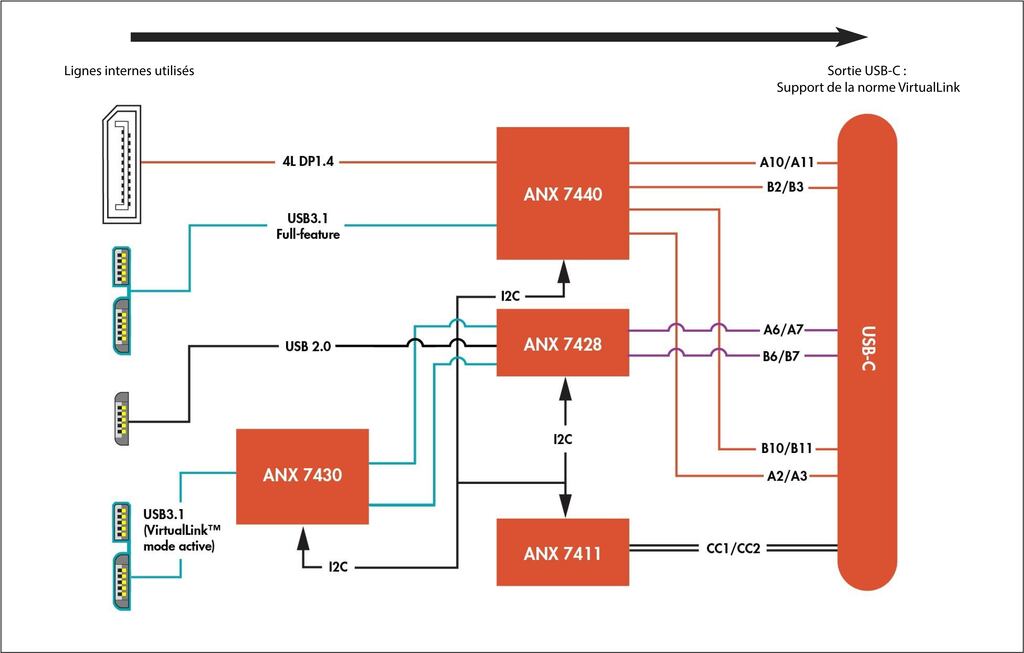
What you need to remember is that there is a minimum of 4 chips for the implementation as well as the mandatory activation of VirtualLink on one of the USB 3.0 ports. The conductor here is the ANX 7440 proposed in August 2018. It is a circuit that integrates many things including re-timers that are necessary for the proposed data rates and the most interesting fact here is the loss limit for USB which is precisely 23 dB. You will tell me that everything should be fine and that the signal should be able to pass in a 5m cable since the loss of a 5m cable is around -21dB. Yes and no
Another chip for mobile but actually for all media as noted in the pdf, this time does exactly the same thing, same specifications but with a different name ANX 7451 dating from November 2019. Now let’s take the case of an active cable with this chip under the RD1011 design, nothing really spectacular a small detail catches the eye, the limit of the cable goes to 4m. To summarize we go from a maximum link of 5 m in active in August 2018 to a link of 4m in active in January 2020 (NB: An active cable is a cable that has within it controllers with either re-timer or re-drivers to re-boost the signal, this to extend the length of the cable well beyond the maximum length of a passive cable)
For information this cable as its title indicates is dedicated to VR, especially to the connection with HMD. Other info if you look at their video presentation of the 7440 you can see that the connections can clearly fail and if you just re-drive the results are catastrophic.
(I won’t go into details, just know that a re-timer is better than a re-driver ok)
Several clues lead us to think that as the tests went on, the VirtualLink was not showing all its capacities in terms of maximum length and stability of the connection and gave a good reason to Oculus to develop its own technology for example.
Example of integration
One might wonder how Nvidia manages to offer VirtualLink without the help of the 7440. After some research, it is certain that the card does not switch the USB-C ports present on the motherboard but has its own USB 3.2 gen2 controller in the die. Then there is a chip (a USB Type-C controller) that is used to control the USB-C connection, including the configuration of the latter (Alt-Mode, VirtualLink, power output, etc. …). The chip in question is a version of the CYPD 4136.
If we check the design of the 2080, 2070, 2060 and even 1660ti chips, they all have the famous USB controller integrated in their die (and as a picture is never too much …)
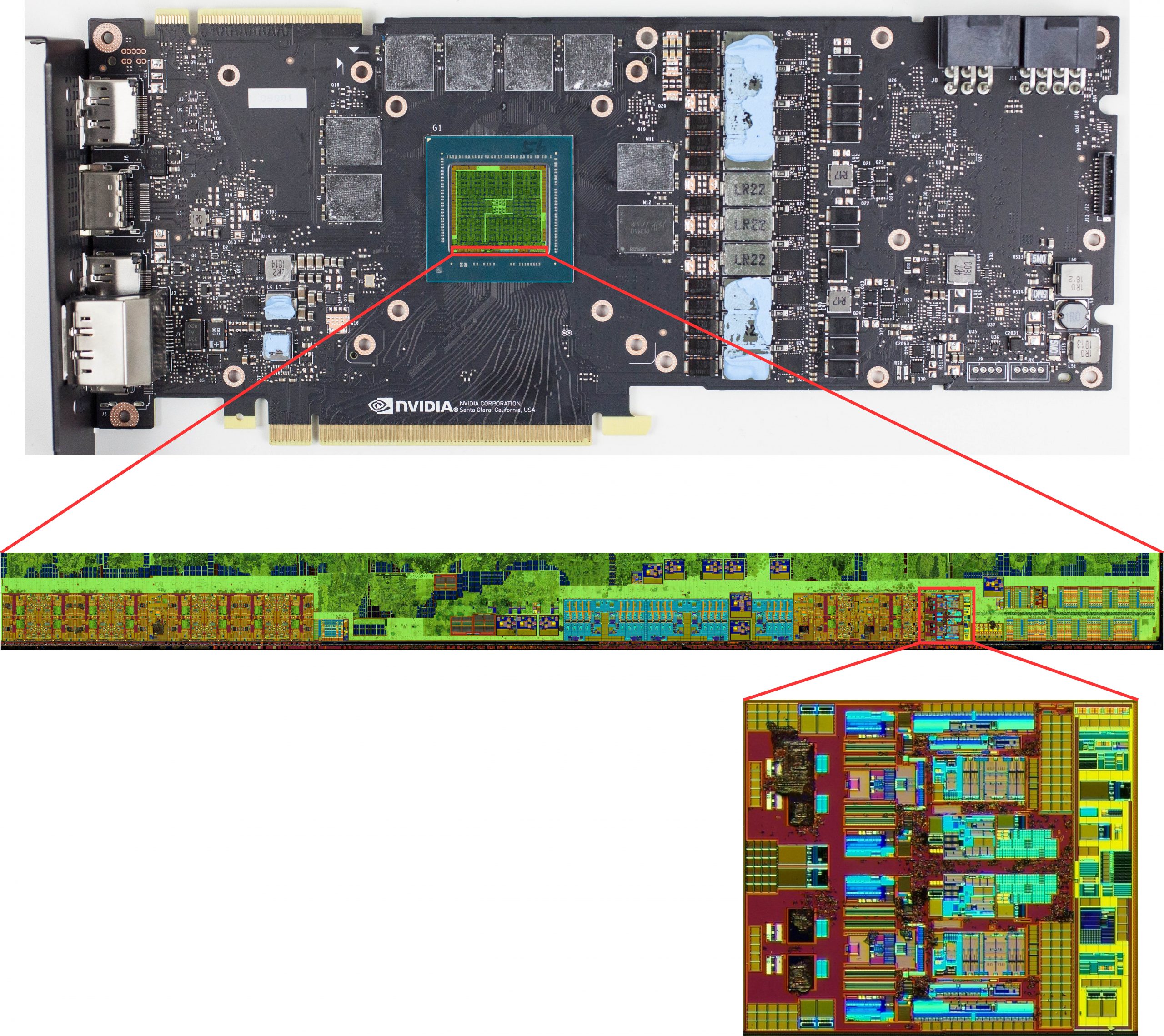
(Photo credits: Fritzchens Fritz)
Here is a zoom from the die of the 2080 to the USB controller.
Nvidia clearly states that it is the manufacturers who did not want to implement its solution, but as far as the partners in charge of offering their graphics cards, with a custom PCB or not, in desktop models it is exactly the same.
The implementation of USB-C declines as the range goes down. The 2060s, they have only a handful of custom models with USB-C. This is because manufacturers who have their own custom PCBs, especially at the lower end of the market, will try to keep costs down. So the USB-C and the associated chip disappear.
So whether it’s on the laptop side or on the partner board side, the solution has not really caught on. For Analogix their alternative solution to Nvidia with 4 different chips could have been a good solution because it does not depend on gpu manufacturers, and allows maximum compatibility. But it is even less practical than Nvidia’s solution which only requires one additional chip compared to Analogix’s solution.
Laptop manufacturers did not play the game. But because of the lifespan of a platform, which is generally 2 years, changing the motherboard to this extent is impossible given the renewal. Especially since laptop manufacturers are not particularly pro active with new standards.
Only one completely new platform has this famous virtualLink, it is the Mothership from Asus.
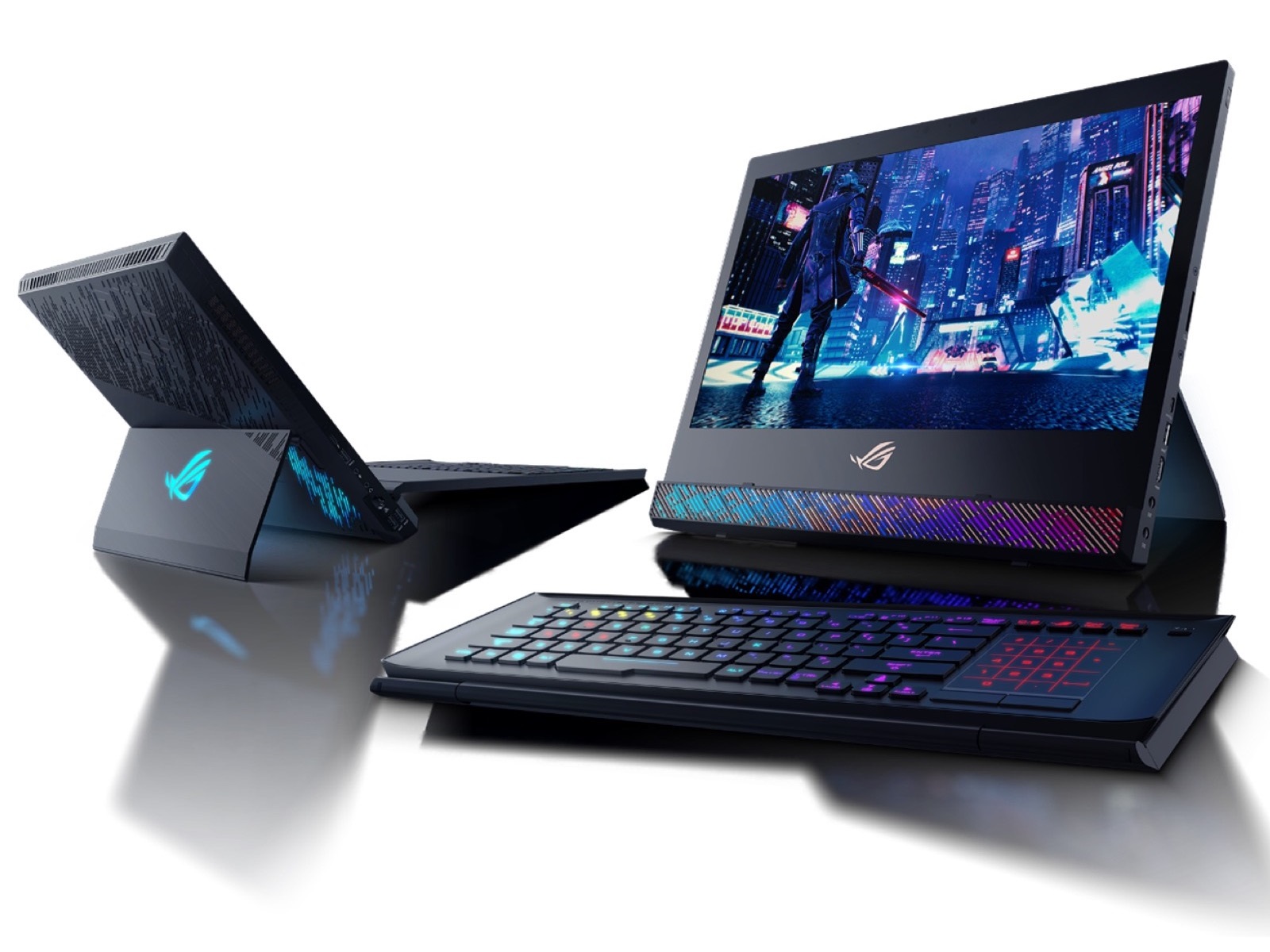
A concept dedicated to performance with the sole purpose of showing the talent and engineering of Asus. There is mechanically a USB-C plug dedicated to VirtualLink and another one to Thunderbolt. Unfortunately I don’t have enough details about the VirtualLink implementation but it should not differ from Nvidia’s one.
Only some very high end platforms offering 2 USB-C could have integrated this technology because offering a classic USB-C without Thunderbolt would have been suicidal (from a marketing point of view) on such high end machines.
(NB: I will do an article soon on the exact implementation of USB-C on the RTX 2000 and RX 6000. Be aware that this is quite different from the implementation done by Analogix).
Conclusion
Therefore the time when it would have been possible for manufacturers to adopt the widespread VirtualLink would have been at the dawn of the new generation with the RTX 3000. But since Nvidia abandoned VirtualLink on the way, the disappearance of a USB-C would have created a problem (since it would have been connected to the gpu). Putting 2 USB-C ports is a challenge for mid-range-high end laptops. Nvidia had to communicate with its partners well before the release of the 3000 on the disappearance of the famous connector since the design of the die was to be completed well before the final release. They then preferred not to integrate the USB-C VirtualLink output from the GPU, even during the last refresh in mid 2020, so as not to lose a USB-C output and redo the whole motherboard.
Here Nvidia has clearly dug the grave of VirtualLink without it having time to defend itself.
AMD has no say in the matter since it is almost non-existent on the laptop market.
We will see in March if AMD will really abandon the port on its Navi 22 (chip that will be for the 6700 and 6700xt) and if it will hypothetically be implemented on the laptops that will be equipped with its chips.
Thus, the low growth of the sale of VR headset (compared to what was hoped), the lack of investment of the major VR headset manufacturers to the immobility of laptop manufacturers as well as the announced death of the connector by Nvidia led to the loss of VirtualLink.
In the end, the VirtualLink is a promise, a promise that could have helped democratize VR, make it all plug and play, so that we don’t have to resort to three different cables to connect and in the best case scenario, do without HMD.
Unfortunately, this promise, like many others, was not honored in the end.
The democratization of headsets did not happen as hoped. And although the VR market is slowly but surely growing, it is not enough for the big players. The introductory prices are still relatively high for Vive, while Oculus is starting to offer a “relatively” affordable price. In the end, the best solution is the one adopted by Oculus on the Quest 2: go wireless.
Wifi 6E (11Gbps) and its future versions may be the Holy Grail in order to enjoy high resolution headsets with low latency in complete freedom.
I hope you enjoyed the article and that you didn’t take too many aspirin while passing^^
